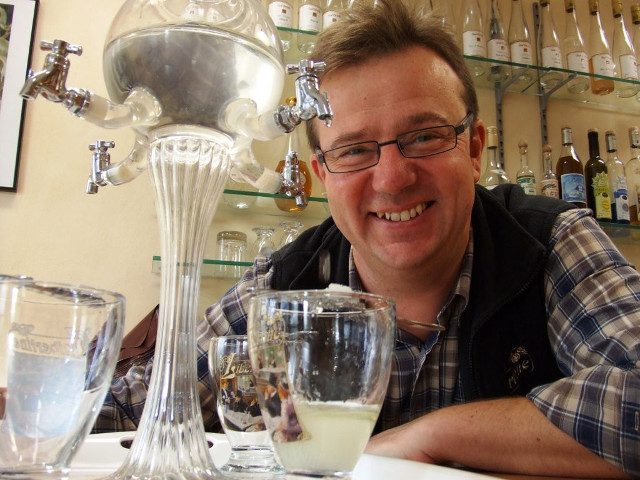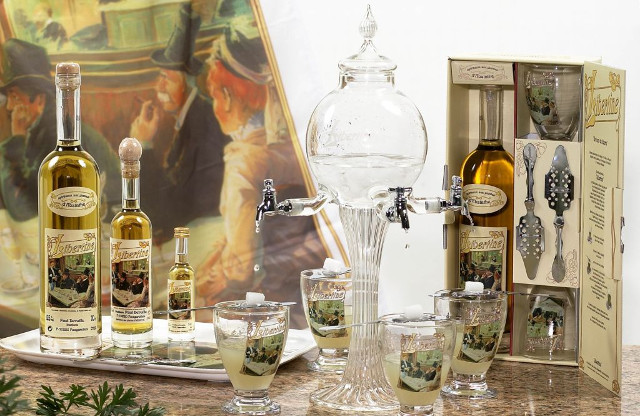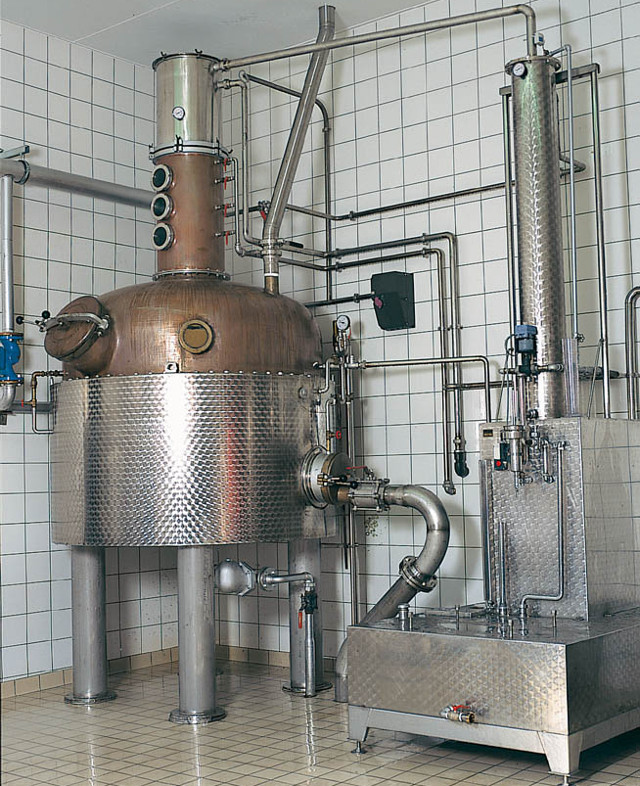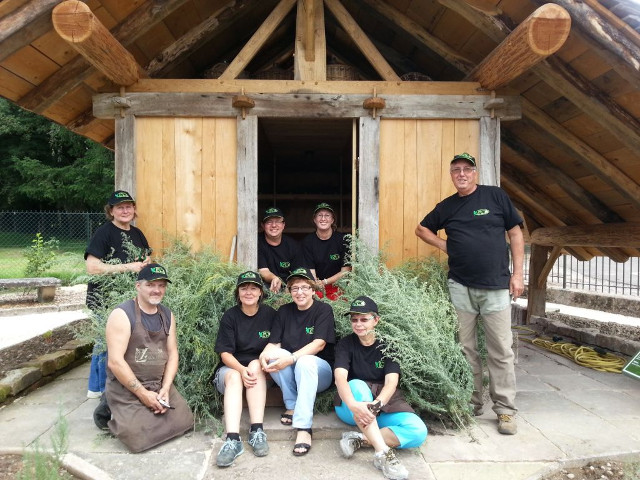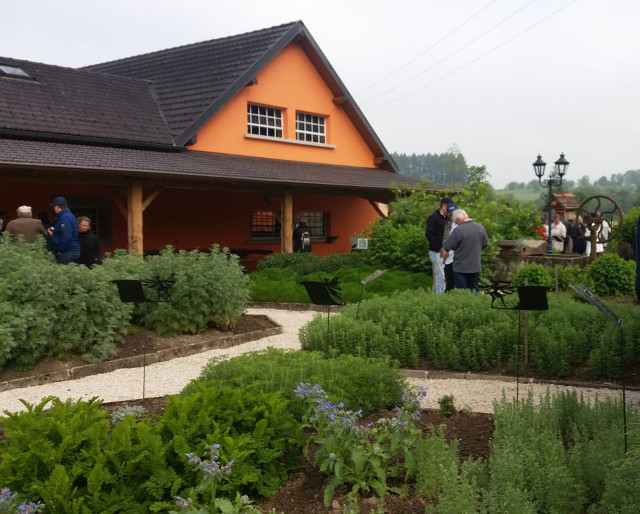The town of Fougerolles in eastern France is often associated with fruit brandies. Several distillers settled there in the 19th century to take advantage of the local large-scale fruit-growing. The locally produced cherry brandy, the "Kirsch de Fougerolles," was especially popular and is still regarded as one of the signature products of the area. The product description is protected today as a "controlled designation of origin."
One of the distillers of the Fougerolles was Xavier Devoille, who settled in the town in 1859. His son Paul expanded the business and established it as one of the most important distilleries in the region. By the late 19th century the distillery had begun to distill absinthe, in addition to producing the regionally common fruit brandies.
The distillery has been a family business since the 1985 business takeover by Rene de Miscault. The current CEO is Hugues de Miscault, who took the time to answer our questions.
We are an artisanal and familial company. The distillery Paul Devoille just received the label “firm of living heritage”, a state label which rewards companies that possess a rich expertise and holdings.
This label is awarded by the French government to companies who display particular traditional manufacturing skills within a limited geographical region - a testament of the distillery's devotion to historical authenticity.
Our production methods are identical to the ones used a hundred years ago : the same plants, the same techniques.
The old house recipes are used for the production of the house-branded absinthes:
When we decided to start making absinthe again, we took back our old recipes from that time. They were kept in the “Musée des Eaux de Vie” in Lapoutroie (Alsace).
Today this museum is operated by Rene de Miscault, while management of the distillery is overseen by his son Hugues.
While the required knowledge for absinthe production was readily available through the old recipes, the resumption of absinthe production was not without problems.
These recipes used units of measure from back then (one botanical bucket of this plant, one botanical bucket of that plant… ) It took us approximately a year and many trials to find the best plants and the best proportions to finally end up with this satisfying recipe.
The absinthes
The result of those efforts is a product portfolio of several absinthes, distributed under the house label:
Libertine Originale 55%
Libertine Amer 68%
Libertine Intense 72%
Fleur d'Absinthe
Absinthe du Centenaire
Absinthe La Charlotte
Other absinthes are additionally produced for distribution by other companies:
Absinthe Soixante Cinq
Verte de Fougerolles
Blanche de Fougerolles
A seperate line of absinthes, the "Les Parisiennes", are produced for an absinthe specialty store in Paris, "Vert d'Absinthe". Several of these absinthes are made in the Distillerie Paul Devoille:
La Coquette
L'Enjoleuse
La Desiree
This large selection of products is a clear sign that absinthe production is a big part of the distillery's business:
Absinthe has been one of our flagship products since the beginning of 2000.
This level of commitment has been rewarded with several awards from international competitions, including the silver medal of the International Spirits Award for the Libertine Intense in 2013 and the Master Award of the Absinthe Masters 2011 for the Absinthe Blanche de Fougerolles.
The production
The production of the absinthes is conducted via a unified standard:
All our absinthes are produced in the respect of old traditions. They are made exclusively with botanicals (absinthe, fennel, liquorice, melissa, anise, angelica, hyssop…) No artificial coloring, no sugar.
A more detailed description of the process affirms the emphasis on historically authentic production methods. The historical technique of maceration with subsequent distillation is utilized for production.
The plants are dried, and then put to macerate in alcohol. They are afterwards distilled. We get a distillate. We put together a blending of the plants’ distillates, which ends up with the basis of absinth, called spirit.
The spirit is put in the alembic with the plants. The whole is heated lightly in order to extract the plants’ chlorophyll, that’s the reason of this green color and its additional flavors. Depending on the botanicals used, and the duration of heating, we get different shades of green, going to green-yellow to green-brown.
The only deviation from historical production methods is, according to Hugues de Miscault, a technological improvement of the alembics:
Only the heating in the alembics is more precise today, because our alembics are low pressure steam-heated, which allows temperature regulation much more easily than a century before.
Hugues de Miscault considers the quality standards of his distillery to be common among French producers.
Generally, in France, the absinthe market is rather qualitative. French absinthe producers make absinthe of quality, stemming from ancient recipes. It’s more or less identical in Switzerland. On the other hand, in the rest of Europe, we find fluorescent green, blue and pink absinthes, all colors…
Authentic Absinthe Culture
Many products on the modern German market can indeed be considered inauthentic, as they are produced via non-traditional methods and are often artificially colored. Why are these products so common in Germany and Eastern Europe?
Unfortunately, these products are popular because they are fun, they have nice colors, they are trendy. But they are not real absinthe. These producers target young customers, sell their products in bars and nightclubs and communicate through social media. But their absinthe is totally denaturized and these consumers don’t know the “true” traditional absinthe. We are far away from the standards of quality of French and Swiss producers. That’s too bad, in particular for young consumers.
Many German consumers often speak of a specific intoxicative effect of absinthe, which supposedly exceeds the effects of other alcohol. Hugues de Miscault ascribes this to a higher concentration of alcohol:
Like every alcohol consumption, from any sort, absinthe produces a feeling of well-being, an euphoria. But indeed, its effect is maybe more intense because of its strong degree of alcohol. Some consumers put just a little water, or even none at all.
The alleged intoxicative effect of thujone is perhaps the most persistent myth, spread not only by misinformed consumers but by some producers and dealers.
We never used the argument "thujone". We thought that it wasn’t an argument. It is completely possible to produce very good absinthes with very low thujone content.
The absinthe culture in Germany suffers not only from misinformation. Producers of inauthentic products often conduct aggressive marketing, which leads not only to dubious myths and rumors, but also to inauthentic drinking rituals. The best example is the "Bohemian ritual", which involves the flaming of absinthe-doused sugar. While many absinthe drinkers consider this an historically authentic method, it is in reality a modern invention.
Since the beginning, we have always recommended tasting absinthe according to the traditional way, following the ceremony from the old times: the water fountain, the sugar, the spoon.. and it’s what the customers like. The service of absinthe between friends must be a friendly moment, a moment about sharing. An absinthe must be deserved. The wait during the preparation of the beverage gives more power to the tasting.
We don’t recommend burning the sugar to our customers.
The price difference might be another reason why inauthentic products are so popular among young consumers. Authentic products are often more expensive than inauthentic products.
Indeed absinthe is a costly product. It is expensive because it requires sometimes complex recipes with many ingredients, and it requires a particular expertise. But you should not forget all the taxes on alcohol which represent a huge amount of the cost. We don’t think the states are ready to lower the taxes, on the contrary…
Some serious producers and dealers endorse the introduction of a legal product definition for absinthe, which would ensure only authentic products could be labeled "absinthe". The Distillerie Paul Devoille supports this approach.
Yes, absinthe must be regulated by law. Switzerland adopted an interesting regulation which respects the historical and traditional aspect of absinthe. This type of control should be spread to the rest of Europe.
Why has this been impossible so far?
The setting up of such a regulation at the European level is difficult because there are two sorts of company that produce absinthe.
- Storekeepers who only think about immediate profit.
- Producers who have a more respectful vision of absinthe and its history and who have a long term vision.
The two categories have different and incompatible visions. So setting up a unique regulation is complicated.
The secret garden
The Distillerie Paul Devoille is evidently wholly committed to historic tradition, from the production processes and the culture of the drink, to its support of political measures for a protective product regulation. And consumer education is taken one step further. In 2014 the Distillery opened its own garden, "Le Jardin Secret de la Fée Verte", which is open for visitors all day. Many of the herbs are there manually planted, harvested and dried, later to be utilized in the many different absinthes.
The "Absinthe du Centenaire" is a newly created product, made in celebration of the 100th anniversary of the 1915 French absinthe ban. This absinthe has already received awards; the Best of Gourmet selection 2015 and the gold medal of the Concours Mondial in Bruxelles, 2015.
Three different types of wormwood and other herbs are used in the production of this absinthe, all grown in the on-site garden.
Our customers often ask for pieces of information about plants used to produce absinthe. Many think there is only the plant “absinthe” in it. To answer their curiosity, we created a garden which presents all the plants used in the production of absinth: Melissa, hyssop, angelica, fennel… without forgetting a collection of Artemisia, with Artemisia absinthium and Artemisia pontica.
Official Website Distillerie Paul Devoille
Facebook page Jardin Secret de la Fée Verte

